And if you don’t have the money, you should invest the time?
I have found myself in a position where I didn’t have either many, many times. However, despite the fact that healthy eating can be a serious commitment, the one thing I TRULY can’t afford is sacrificing my health at the altar of the ‘hustle’ because if I do then it’s gonna cost me waaayyy more in the future.
I’m guessing that we share the same concerns.
The sad truth is that in many places, the healthier you want to eat, the more expensive it’s going to get. But that doesn’t mean you can’t eat healthy on a tight budget. And of course, enjoy every meal as well.
So that’s what I’ve been doing for the past couple years on my perpetual ‘college kid’ budget.
Here are my low budget food hacks.
How to Eat Healthy on a Tight Budget and a Busy Schedule
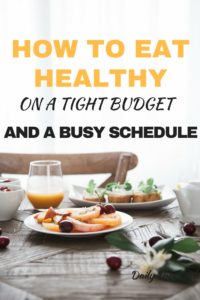
1. Create a Basic Meal Plan and a Grocery List
A meal plan is a basic outline of the foods that you’re going to eat in a particular week. I recommend these 5 steps during the meal planning process, and it takes me about 20 minutes to plan for every single meal for five days. You can consider this time as an investment into not having to wonder about meals for the rest of the week.
Step 1- Calculate the number of macros that you want to eat
We start with this step because you want to ensure that you’re eating the right combination of foods to achieve your health goals. Whether you want to lose weight, gain weight, reduce your consumption of sugar, or anything else, this process will help you get clarity.
The average sedentary woman should eat around 46g of protein {1}, 225-325g of carbs {1} and 44-78g of fat per day {1}.
If your goal is weight loss, you could try to decrease your carbs (50g-150g) or fats while increasing protein. We won’t go into any of the science here because I’ve covered this topic extensively.
If you want to know what your macros are, here’s a free calculator.
Step 2- Identify the foods you want to get those macros from
If you want to focus on a particular food group or completely avoid another, now is the perfect time to do that.
Because we want to eat healthy on a tight budget and on a busy schedule, we want to avoid that are expensive to purchase and time-consuming to prepare.
At the same time, you want to ensure that you’re hitting your macronutrient goal daily. The place that people tend to fall short is protein, so let’s get some ideas for healthy and affordable protein options that are easy to prepare.
- Eggs– 2 large eggs= 12g
- Natural peanut butter– 2 tbsp= 8g
- Canned tuna– 1 can tuna= 20g
- Black beans– 1 cup black beans= 15g
- Lentils– 1 cup lentils= 18g
- Tofu– 1/2 cup tofu= 20g
- Whey protein– 1 scoop= 20g
- Oats– 1/2 cup= 13g
Other options include chicken, fish, garbanzo beans, quinoa, and canned salmon, etc. Beans are a regular for me because they are easy to prepare once they’ve been pre-soaked overnight. They are also great for batch cooking which can save you a ton of time. They can be cooked and stored in the freezer for weeks. Plus, they’re cheap.
If you don’t like beans, tuna, chicken, and eggs are some fast and easy protein options. And of course, you can add your personal favorites.
For carbs, you can use fruits, vegetables, whole grains such as oatmeal, potatoes, quinoa and wheat pasta/flour/rice.
For fats, you can consider coconut oil, olive oil, avocado oil or your favorite healthy oils, There’s also avocado, eggs, nuts and nut butter.
So after you have identified where you want to get your carbs, proteins, and fats from, you can move on to the next step.
Related:
Step 3- Find at least 2 dinner recipes with your chosen ingredients
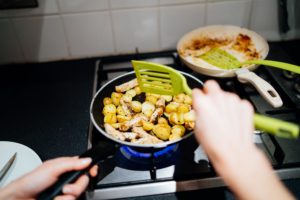
Let’s say you chose black beans, chicken breast, canned tuna, and eggs for this week. You can use simply cook them the way you like, or find two recipes that you’ll enjoy.
These two dinner recipes will be used for dinner for 3 days with leftovers for two lunches. You can increase this number to 3 or even use 1 recipe that you want.
A good mix of the above ingredients would be a chicken casserole and black bean stew for the two dinner options, with the eggs or tuna for breakfast. Or you can have oatmeal with seasonal fruit. That’s what I do 4 out 7 mornings.
You can have these two main dishes with sides like roasted potatoes, quinoa, or a simple salad. These can be made in advance and stored in the fridge.
Again, these are just examples so you can find foods and recipes that work for you.
If the recipes that you find only allow for 2 servings, you might want to double or triple it so that you can get more out of it.
Now that you have your macros and recipes ready, we can move on to the last step in the meal planning process.
Step 4- Create a grocery list with all the ingredients that you need
At this point, you know exactly what you’re going to eat for the rest of the week. You’ve already saved a ton of time.
Now you only need to write a shopping list with everything you are going to purchase. The great thing is that this planning will help you to waste less food, if any. Money saved right there too.
Let’s move on to the next food hack to help you eat healthy on a tight budget.
2. Create a Grocery Shopping Strategy
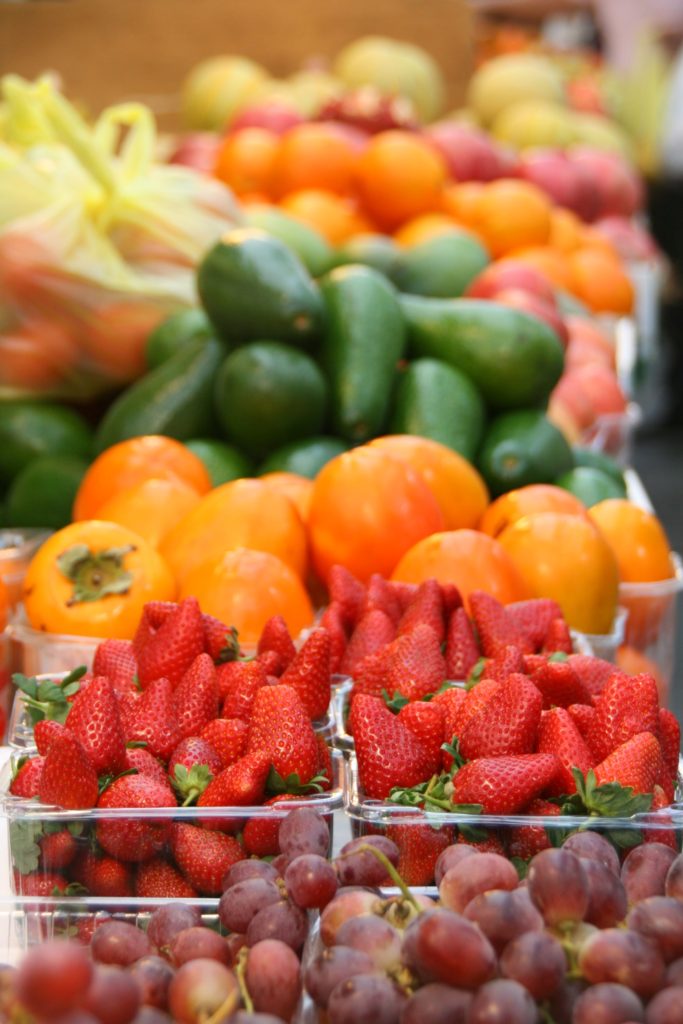
Instead of haphazardly going to buy food 2 or 3 times for the week, you can try these strategies to save money and time. If you’ve created your basic meal plan then you have an idea of what you need from the local market and supermarket.
Shopping Hack #1- Choose a day to shop at local markets for seasonal produce
Is there are a day when there’s a lot of vendors at your local Farmer’s Market?
Chances are high that you can buy more fresh produce at lower prices. That happens every Wednesday and Saturday at my local market, so those are the two days when I’ll go shopping. I’ll spend roughly $15 to $20 on some great stuff, and spend less than an hour doing it.
You can try to save time by doing this with another activity that would take you out of the house and in the same general direction. If you still don’t have the time or a local market near you, you can purchase the items in a supermarket.
You can save money if you purchase seasonal produce in either location.
Shopping Hack #2- Shop in bulk
No, I’m not going to tell you to purchase everything in bulk because that would defeat the purpose of this article.
However, based on your general diet, there are some essentials that you use every day. These things may include cooking oils, spices, coffee, and grains. If you buy smaller packets of nuts often or would like to eat more nuts, then you could purchase these in bulk too.
Other items that you can purchase in bulk are flour, dried beans, and canned goods.
Shopping Hack #3- Shop on Sale or in Discounted Stores
I see you, Aldi.
It doesn’t where you choose. These discounted stores will help you to save money because the items are already discounted. You can also purchase your canned products and pantry essentials on sale if you have spare cash. They will last longer for less money per serving.
3. You don’t have to buy 100% organic
The term ‘healthy’ has become synonymous with ‘organic’ in some places. That doesn’t have to be the case, especially when organic is sometimes as much as 5x the price of regular food.
Unless you have a strong preference for it or you have access to some reasonable prices, you don’t need to buy 100% organic when your budget is ‘broke’.
Here’s why I say this.
There are some items that you should absolutely try to get organic if you can because they might have higher pesticide residues. These are foods like berries and leafy greens that are openly exposed.
However, there are other foods that I personally don’t worry about that much if they are not exposed directly. These are foods like nuts, bananas, and other foods with skins that are peeled off before eating.
I’m not saying that you have to do this- it’s just a strategy that I use when I have a limited budget.
If you’re not concerned about organic/regular produce, that’s totally fine as well.
Once you have your food ready, it’s time for the last healthy eating on a tight budget hack.
4. Do a Full or Partial Meal Prep
Meal prep is different from a meal plan.
Full Meal Prep– This saves you both money and time. If you really don’t want to cook during the week, this will save your sanity.
You can create delicious, healthy and affordable meals in advance and simply reheat them at any time. Do try to supplement with some fresh fruits and veggies during the day so that you get a daily dose of fresh nutrients.
Partial Meal Prep- I don’t know if partial meal prep is a ‘thing’ on the internet but it’s a hack that I use to save time. Essentially, if you can spare ten minutes before dinner, you can consider this option. Here’s a picture of a part of my partial meal prep to give you an idea.
Please excuse the bad lighting and lack of design. It was just another day in my kitchen. 🙂
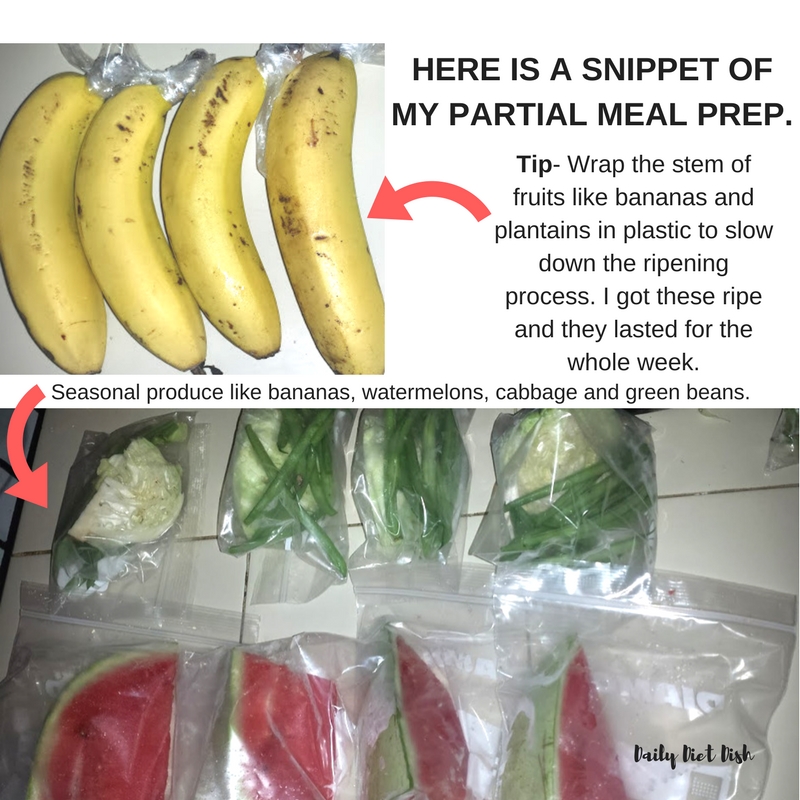
Here’s how I do a partial meal prep:
- Cook one of my chosen dinner recipes and get it ready for the fridge
- Get ziplock bags and pre-portion the veggies and fruits I’m having each day. This way, I don’t have to decide when to prepare veggies from scratch. This is great if you always have to convince yourself to eat vegetables. It takes out the guesswork and makes eating healthy easier.
- Get smaller containers and pre-portion the oatmeal that I normally have for breakfast. If you run out of plastic containers, use small ziplock bags for this.
In the mornings, I simply grab a packaged oatmeal, add milk and prepare it however I like, and then top it with fruits.
In the evenings, I reheat the main protein dish while preparing some fresh veggies as the side dish. It takes about ten minutes to prepare both lunch and dinner with this strategy.
You can also do this with anything that you eat regularly to save yourself some time.
Let’s Recap
When you’re trying to eat healthy on a tight budget, it all comes down to preparation.
You can save time and money by creating a meal plan and choosing the foods that you want to incorporate into your diet. Then you can be a smart shopper and shop in budget stores on sale, buy fresh goods at local markets, and buy in bulk.
Meal prepping is also a great way to save money and time when trying to eat healthily. If your goal is to lose weight, I recommend reading the following articles.
- The 7 Habits You Need for Successful Weight Loss
- The Only Low Carb Diet You Need for Weight Loss
- 7 Proven Ways to Lose Weight Naturally
- 101 Low Carb Foods for Weight Loss
If you found this post helpful, leave a comment below, share, and joining the Daily Diet Dish family!

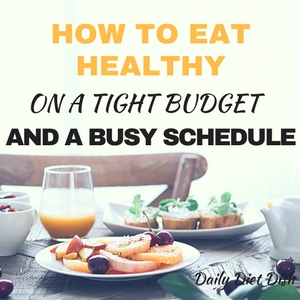
This article is so spot-on to challenge my reasons… AKA excuses… For not sticking to my healthy eating plan. You offer excellent suggestions with very specific, usable information. Thanks for putting this Empowering article together!
This is one of the best articles about eating healthy on a budget I have ever read. It is so detailed! I am bookmarking this.
Thank you so much!
This is great information and tips for easy use. Often I feel as if getting started is that hardest part and this really helps me picture ways to make eating healthy a reality. Great post!!
It really does seem harder before we start, but the key right there is starting. That’s when you’ll see that you can actually do it.
All great advice, now if I could just stick with it!
Just try it for a week and see how it goes! You won’t know until you try.
With the price of food rising, eating healthily while trying to stick to a budget can be challenging. But with a little planning and your useful tips, buying and preparing delicious healthy food on a budget is not as hard as it may seem. Thanks for passing on.
Once there’s a will, there’s a way Jess. Eating healthy is such a good investment in your body and your future.
Thanks for sharing will have to put this into practice because I am terrible at budgeting.
We all are at some point! I’m glad that these tips helped.
Nice article! bookmarked!!
Thanks! Glad you liked it.
Very detailed article ! Never thought or actually heard about the “calculating your macros” part, quite interesting. Thanks.
It definitely takes a bit of work but it’s worth it!